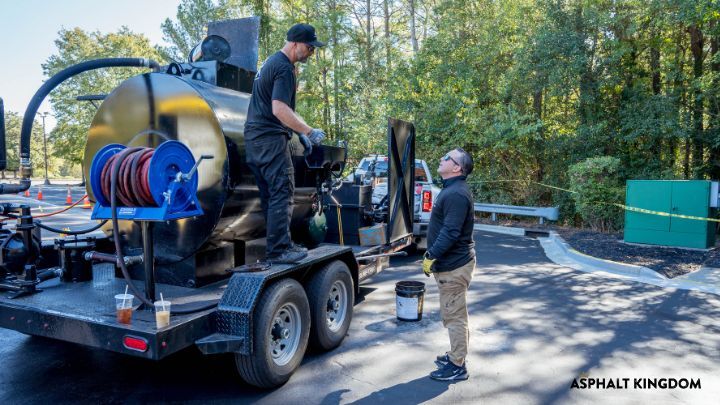When it comes to asphalt sealcoating, there’s a lot of information out there. Unfortunately, not all of it is true - and the wrong information can cost you serious money on every square foot of blacktop you manage.
Below, we tackle the most common sealcoating myths head-on and share practical takeaways to help you keep your pavement protected.
Table of Contents
- Myth #1 – Sealcoat Turns Your Driveway Into a Slip-n-Slide
- Myth #2 – Sealcoating Fills Existing Cracks
- Myth #3 – Sealcoating Is Only for Residential Driveways
- Myth #4 – You Need to Seal Every Year
- Myth #5 – Sealcoating Is a Waste of Time and Money
- More Myths You’ll Hear on the Job
- Putting It All Together
- Quick Recap
Myth #1 – “Sealcoat Turns Your Driveway Into a Slip-n-Slide”
Fresh sealer can feel slick for the first 24–48 hours, but that’s temporary. Modern sealers are engineered with fine aggregates (think very mild sandpaper) that increase surface friction once they cure.
Analogy: Wet paint on a deck is slippery, but once it dries the grip comes back—often better than before. Sealcoat works the same way.
Takeaway: Wait the full cure time, keep traffic off during that window, and your surface will be safer—especially in rain—than unsealed asphalt.
Myth #2 – “Sealcoating Fills Existing Cracks”
Sealcoat is a protective layer, not a crack filler. It slows water intrusion and UV damage, but cracks must be cleaned and filled first. In fact, studies by the Pavement Co-operative Research Program show that untreated cracks can widen 50% in just one freeze-thaw cycle. For best results, pair your sealcoat application with professional crack filling techniques before you topcoat.
Takeaway: Repair cracks, then sealcoat. Skipping the first step is like waxing a car with rust spots and hoping they vanish.
Myth #3 – “Sealcoating Is Only for Residential Driveways”
-2.jpg?width=720&height=405&name=Blog%20Images%20(41)-2.jpg)
Driveways, parking lots, bike lanes, airport taxiways—any asphalt benefits. Commercial lots with regular sealcoat cycles have been documented to double pavement life versus lots left bare, according to data cited by the National Asphalt Pavement Association.
Takeaway: If it’s asphalt, it pays to seal it. Period.
Myth #4 – “You Need to Seal Every Year”
Most pavements only need a fresh coat every two to three years. Annual sealing can lead to needless expense and excess build-up. Exceptions: high-traffic commercial sites or extreme climates.
Takeaway: Inspect yearly, but apply only when the previous coat shows noticeable oxidation (gray color) or wear in wheel paths.
Myth #5 – “Sealcoating Is a Waste of Time and Money”
Think sealcoating is “just paint”? Here’s the real-world cost comparison and savings:
- Residential Sealcoating: $0.50–$1.00 per sq ft (labor + materials)
- Commercial Sealcoating: $0.10–$0.30 per sq ft total
- Overlay Resurfacing (parking lots): $1.00–$3.00 per sq ft
- Full Removal & Repave (driveways): $7.00–$13.00 per sq ft
- Cost Multiple: Replacement is 8–20× more expensive than sealcoating.
- Long-Term ROI: Over a 12-year span, sealed pavement costs $0.39 / sq ft vs. $1.76 / sq ft if unsealed—a ~78 % reduction in total ownership cost
- Lifecycle Savings: Combined sealcoat + crack repair programs typically cut lifetime pavement expenses by 65–75 %
Takeaway: For pennies per square foot today, you defer—and often avoid—the multi-dollar expense of premature resurfacing. Sealcoating pays for itself many times over.
More Myths You’ll Hear on the Job
Myth #6 – “DIY Sealers Are the Same as Contractor-Grade”
-2.jpg?width=720&height=405&name=Blog%20Images%20(40)-2.jpg)
Retail buckets are convenient, but they’re diluted to meet consumer VOC limits and lighten the container. Pro-grade sealers contain more solids, yielding a thicker, longer-lasting film. If you’re a contractor, using consumer-grade sealer is like brushing house paint on a steel bridge—wrong chemistry for the job. Learn more about our contractor-grade asphalt emulsion sealer for professional results.
Myth #7 – “Black Color Equals Quality”
A rich black finish looks great, but color alone doesn’t prove durability. True performance comes from the binder type (coal-tar, asphalt emulsion, or acrylics), solid content, and proper sand/load additives.
Myth #8 – “You Can Sealcoat Anytime the Sun Is Shining”
Temperature and humidity matter. Industry guidelines recommend air and surface temps above 50 °F (10 °C) for at least 24 hours. High humidity or cold nights can double cure time, trapping moisture and causing premature peeling. Check our temperature cheat sheet for sealcoating before scheduling your job.
Myth #9 – “Power Washing Is Optional Before Sealing”
Sealcoat bonds to clean, dry asphalt. Dirt, oil, and growth act like Teflon. Skipping surface prep can cause 30% adhesion loss—meaning the sealer will flake away long before its time.
Putting It All Together
Sealcoating isn’t a magic cure-all, but it is one of the smartest maintenance steps you can take. By separating fact from fiction you’ll:
- Extend pavement life by years
- Cut long-term repair costs in half or more
- Keep surfaces safe, attractive, and professional
Ready to Act?
- Inspect & Repair: Fill cracks first—consider a hot-applied crack filler for best results.
- Choose the Right Sealer: Contractor-grade asphalt emulsion or coal-tar alternatives deliver the longevity you expect.
- Plan the Weather Window: Shoot for warm, dry conditions and block traffic for at least 24 hours.
When you’re ready to lay down that protective coat, our sealcoating spray systems makes the job fast and even—perfect for pros and DIYers alike.
Quick Recap
- Slip concerns? Gone after curing.
- Crack repair? Do it before sealing.
- Frequency? Every 2–3 years, not annually
- Application scope? Any asphalt surface.
- ROI? Saves up to 65% on lifecycle costs.
Protect your pavement, protect your wallet—and never fall for these asphalt sealcoating myths again.
-2.jpg?width=720&height=405&name=Blog%20Images%20(39)-2.jpg)





-1.jpg)